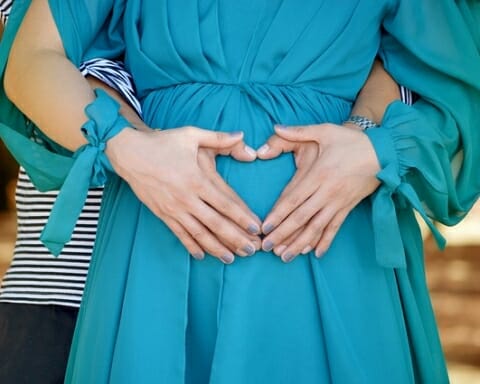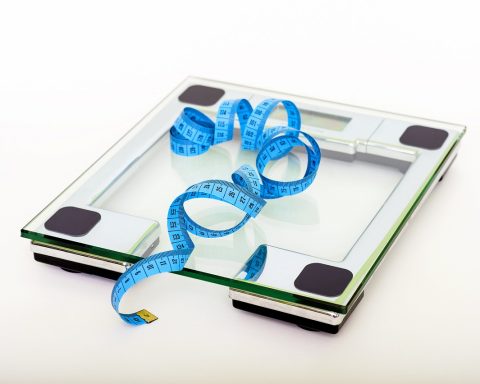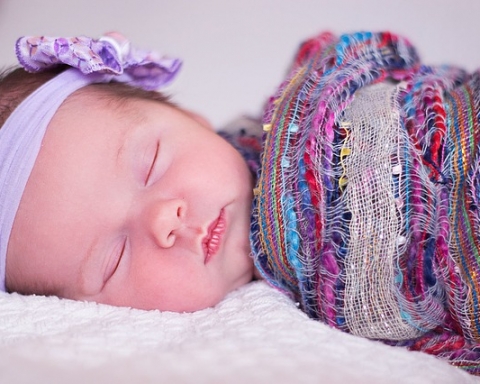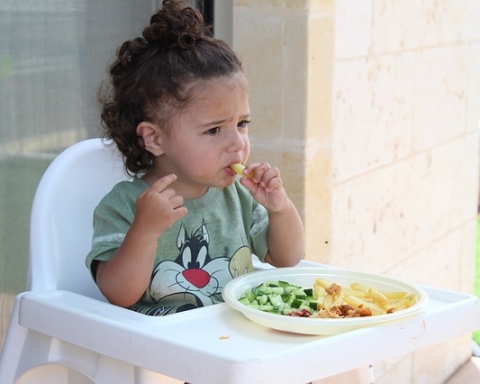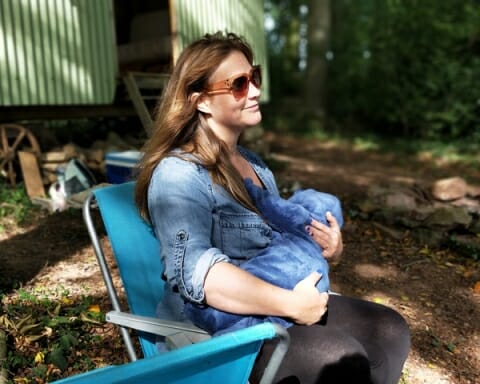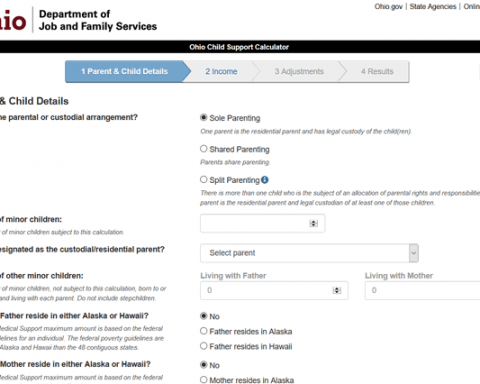Pregnancy, also called gestation, is the period of time when one or more offspring develop in the womb of a woman. The condition usually lasts for a duration of approximately forty weeks. Pregnancy occurs when the ovum is fertilized by the sperm. Fertilization happens through either sexual intercourse or artificial insemination, where specialized personnel manually fertilize the egg.
Also, read more articles on this website
- How Pregnancy Due Date is Calculated?
- Can You Get Pregnant on the 21st Day of Your Cycle?
- What is the Safest Time not to Get Pregnant?
- What are My Most Fertile Days?
Pregnancy symptoms include missed periods, frequent urination, unusual hunger pangs, tender breasts, and nausea and vomiting. If a woman experiences any of these symptoms, the pregnancy can be confirmed via pregnancy tests at a clinic. A pregnancy is divided into three trimesters, numbered in weeks, based on the baby’s stage of growth. A fertilized egg starts as just a group of cells and then gradually develops into an embryo, then a fetus, and eventually into a full-grown baby.
First Trimester Weeks
The first trimester runs from week 1 to week 12.
Week 1 to Week 5
During week 1, the egg is being fertilized by a sperm in the fallopian tube and slowly moving down into the uterus. It is difficult for any woman to tell that she is pregnant during the first week. The most obvious sign would be a missed period. However, most women’s cycles fluctuate, so a woman may easily assume that her period is just delayed. Even a pregnancy test might not read positive because the woman’s hormones are not adjusted yet. Other symptoms of early pregnancy include tiredness, some nausea and vomiting, a little bit of breast tenderness, and spotting (also called implantation bleeding).
In week 2, the baby is merely a group of cells implanted on the wall of the uterus. Women exhibit the same symptoms as week 1, but now the body has started to regulate its hormones. Women may notice some spotting on their underwear. Their sense of smell might become acuter, so women may start to notice petty scents like perfume or coffee. One of the more noticeable symptoms is the vaginal discharge is thinner and stretchier than usual. Because the hormones are more active, the breasts feel more tender than normal as well. Women also may start to experience morning sickness and fatigue.
Week 3 of pregnancy is typically when women test positive. The baby is still just a blastocyst that can’t even be detected by an ultrasound. The symptoms will likely be the same as those of weeks 1 and 2, but women tend to have a more sensitive sense of smell to the point where they are nauseated and have the urge to vomit. Body weight may change a little, but the amount of weight gain varies from person to person.
In week 4, the embryo is visible and divided into parts, and some of its parts have started to develop already. At this point, women may find out if they are carrying twins, triplets or more. Women start to experience mood swings due to their fluctuating hormones and stress levels. The body feels bloated or a little puffed up, especially around the abdominal region. Women might also experience minimal cramping, which is usually a sign of successful implantation. Morning sickness is at its peak now, and women may feel a little more fatigued as well.

What to Do
Between weeks 1 and 4, the first step should be to take a pregnancy test. Once the pregnancy is confirmed, pay a visit to a nurse to start planning prenatal care. Pregnancy will require many lifestyle changes and adjustments. Start taking prenatal vitamins to boost health during the pregnancy. Reduce alcohol intake and stop any other practices that may put the baby at risk.
In addition, eat foods rich in folic acid, whole grains, fresh fruits and vegetables, proteins, and healthy fats. Take nutritional supplements if needed. Water intake is highly encouraged to help keep the vital organs active. Consider opting for smaller, more frequent food portions instead of large servings. If necessary, avoid foods and smells that trigger extreme nausea. Sleep more and supplement with daytime naps. Do not forget to exercise. Keep physically active to reduce muscle tension and to help the body relax.
Week 5 to Week 12
At week 5, the baby looks more like a visible, C-shaped tadpole. Some of the baby’s organs are beginning to develop, including the heart. Formations that will eventually develop into limbs are beginning to appear at this stage. Week 5 is also when changes to the mother’s body start to become more visible. As the baby grows and develops, the abdominal region may start to pop out, especially if the mother is carrying multiple babies. Morning sickness becomes more severe, and urination increases. The breasts are sorer, and the nipple area starts to darken.
Pregnancy symptoms in week 6 are the same as those in week 5. Body weight, however, also increases because the baby is now forming into a mass. An ultrasound can be conducted at this stage to confirm that everything is okay. Women should have their first prenatal visit to the doctor around this time.
The baby starts to become more distinct at week 7. The limbs and body lengthen a little. The baby’s size increases minimally overall. The baby’s main organs, such as the heart, liver, and kidneys, continue to develop, and the placenta grows and starts feeding the baby with oxygen and nutrients. Week 7 will probably include new, more peculiar signs and symptoms. Some women develop acne, especially around the face, as a result of the hormonal surge. (A doctor can provide a remedy for the acne.) Women sometimes experience food aversions as well. They tend to shun favorite dishes and have cravings for strange and unusual foods. Some women start to spit up more saliva than usual. All these symptoms are normal though and will be over soon. They are simply signs of hormonal changes from the pregnancy.
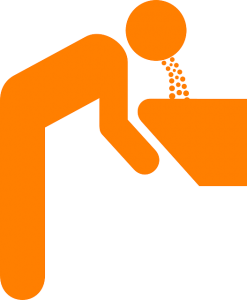
By week 8, both the baby and the mother are growing rapidly. The baby’s size, length, and weight are increasing gradually and so is the mother’s weight and size. The baby’s skin is developing and is translucent. The eyelids are forming, the nose is starting to protrude, the neck is becoming longer, and the upper lip is taking shape as well. The baby does not look like a reptile anymore but rather like a baby-to-be. The symptoms are pretty much the same: bloating, nausea, fatigue, and sensitive smell.
The baby is growing faster by week 9, with the limbs now more noticeable and extended. Most importantly, the baby’s sex organs are now forming. In addition, the ears, eyes, lips, and nose are becoming more defined. Women experience the same signs and symptoms of prior stages but on a more severe note. More nausea and more frequent urination occur. They also have even deeper mood swings and fatigue.
At week 10, the baby has completed most of the crucial developments and has increased in size and length. The tissues and organs are maturing at a rapid rate. Vital organs, such as the liver, heart, kidneys, and brain, start to function. The baby’s spine is also fully formed now, and the skin is coloring up. Mothers start to prefer loose-fitting clothing that is more comfortable around the belly. The breasts increase in size as the mammary glands begin to produce milk. There is an increase in fatigue, vaginal discharge, and morning sickness. Women may also develop visible veins similar to varicose veins, which appear because the heart is pumping more blood to the baby.
By week 11, the baby’s head is more than half the size of the baby’s entire body because of the developing brain. The baby is learning to breathe now and the heart beats a lot faster than the mother’s. The fingers and toes are no longer webbed, and the baby’s genitalia are now more visible. Vaginal discharge increases, so women may feel more comfortable if they use panty liners. Women might also want to be cautious about what they eat to prevent constipation. Fatigue, nausea, and mood swings are still present. One new symptom that may occur is painful leg cramps.
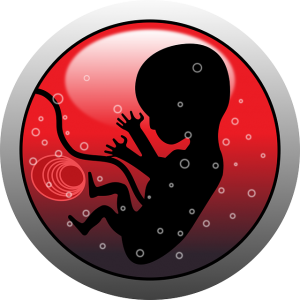
Week 12 is the end of the first trimester. The baby’s reflexes are now functioning, and the mother feels the movements. The toenails and the fingernails begin to develop. The baby is now 2.13 inches long! The mother’s body is growing accustomed to the developing fetus. Fatigue and morning sickness may finally decrease because the hormones are now calming down. Some symptoms, however, may still continue, such as spotting, vaginal discharge, and dizziness. By now, the mother’s belly is growing to accommodate the growing baby. The mother may show even more if she is carrying twins.
What to Do
Continue maintaining a clean and healthy lifestyle. Especially avoid alcohol. Invest in maternity bras to support the growing breasts. Also, get some loose-fitting pants and dresses to give the expanding baby bump more room. Get more panty liners to help manage the vaginal discharge. Attend more prenatal sessions, and get nutritional advice because the baby depends on the mother’s healthy diet to grow. Folic acid and calcium, in particular, help the baby develop strong bones. Drink more water and exercise more often to strengthen the muscles and help support the baby. Consult with a doctor about any symptoms, such as acne and protruding veins. Consider telling friends and loved ones about the pregnancy!
Second Trimester Weeks
The second trimester spans from week 13 all the way to week 28.
Congratulations for reaching the second trimester! By week 13, the baby is the size of a lemon. The eyelids are fully formed and fused together, and the baby appears to be sucking. The hands and legs can move now, and the mother feels the kicks. The baby has also developed fingerprints. The baby’s body size is finally catching up with the head size.
By week 14, hair is starting to grow all over the baby’s body to keep the body warm. The eyes and ears move into their permanent positions, and steady growth continues up to week 18, when the baby starts to produce urine. Women have a higher sex drive due to increased blood flow to the pelvic area. Appetite and energy level also increase. The abdomen starts to pop out more to create room for the expanding uterus. Hormones can cause more hair growth, both in length and volume, in some women.
Between weeks 18 and 20, the baby develops veins, and the kicks and jabs become more vigorous. The baby can sense light and can even hear now. The baby is at 6.0 inches and growing fast, adding on baby fat and more flesh. The mother is halfway through the pregnancy. Her body weight is surging, and the belly is now visible. Women develop stretch marks on their widening bellies and more breast growth. A higher sex drive triggers more vaginal discharge. Women may have painful leg cramps and more pronounced varicose veins. Women may also experience shortness of breath, more fatigue, and have trouble sleeping.
Week 21 to Week 28
At week 21, the baby’s heart is fully formed, with all chambers in place, and has even stronger heartbeats. More baby fat is growing, and thus the skin has more color. The bones are getting stronger, and the baby is starting to develop marrow. By now, the baby is ingesting small amounts of amniotic fluid, mainly for hydration and to test its swallowing skills. Women experience the same symptoms in week 21 as they did in weeks 18 to 20: higher sex drive, more energy, varicose veins, and shortness of breath.
In week 22, the mother’s body experiences drastic changes, especially in the skin. The area around the nipples turns darker and darker. The feet swell more, the belly button protrudes, and the belly gets rounder and bigger. These body changes cause fatigue, backaches, and shortness of breath. There is also more growth in the hair, fingernails, and toenails. The fundal height should be roughly between 20 and 25 cm at this point, and the baby’s length is approximately 11 inches.
Women still have backaches and swollen feet at week 23, but they may at least be rid of nausea and fatigue for the time being. Mothers should have gained about 15 pounds by now, which essentially protects the baby and the mother from preterm incidents. The baby is more rigorous at night, which may keep the mother awake. Mothers should nap during the day when the baby is quiet and still. By now, people should be able to communicate with the baby by song, voice, or even gentle belly rubs.
From week 24 to week 28, the baby starts to look more like a newborn. The baby is now safely incubated to grow to maturity. The brain is developing more rapidly. The skin is almost fully formed but is a bit wrinkly due to the fast growth rate. The lungs are fully developed. The hands are stronger and can actually grab and play with the umbilical cord. The baby can now open and close the eyelids easily, and most of the other reflexes are now stabilized. The baby has also grown hair and weighs approximately 1.68 pounds.
At this stage, most women develop gestational diabetes and will need to be tested in order to curb its effects before it impacts mother and baby. The mother’s belly is now growing at a rate of half an inch per week. Due to the weight gain over the weeks, mothers experience back pain and leg cramps. They also feel occasional fatigue and shortness of breath. Women may also suffer from a lack of sleep because the baby is more active at night.

Important Note
The second trimester is critical. Mothers need to maintain a clean, healthy lifestyle to avoid preterm labor. Constipation and other digestion issues, such as heartburn, are likely to occur. This is also the point at which mothers might develop gestational diabetes and other pregnancy-related disorders. To avoid these health risks, reduce the intake of carbohydrates and fats because they will make the baby extra big. Eat healthy foods and take any necessary nutritional supplements. Mothers need to sleep more, even if it means taking power naps during the day. Invest in relaxing massages to soothe leg cramps and minimize varicose veins. Opt for loose-fitting clothing and maternity wear to increase comfort. Implementing these habits will help mothers better manage pregnancy and hopefully prevent any problems.
Third Trimester Weeks
During the third and last trimester, most women are preparing to receive their bundle of joy. Mothers must take absolute care of themselves. The baby is only a few weeks away now. Also keep in mind that due dates are only approximations, and it’s possible the mother will have the baby before the fortieth week. Sort out the petty details, such as which doctor will attend the labor and birth and where labor will take place. Also, by the third trimester, most women know the sex of their baby because of scans and ultrasounds and so may have already picked out the baby’s name.
Week 29 to Week 40
In week 29, the symptoms of week 28 are still present. Mothers also, however, have increased bowel movements because the baby is big enough to press against the bladder. Mothers also experience constipation and itching on the belly.
By week 30, the baby is producing blood cells and the marrow is fully developed. The baby has grown more body fat and muscle and thus has grown bigger and longer. The increased growth makes it even more difficult for the mother to sleep and causes more digestion issues, such as heartburn and constipation.
The most exciting thing about week 31 is that the baby’s head is now facing down. The baby is roughly 3.5 pounds and 16 inches long. The mother has gained as much as 27 pounds (or more if the mother is carrying twins). The mother’s belly is quite big by now, and she has more bowel movements. The breasts have a light-yellow leakage, which is a sign of ready breast milk.
In week 32, the baby’s movements are more frequent due to the increase in size and decrease in space. Mothers may experience some minor contractions but not to worry. The cervix is simply getting ready to open up.
By week 33, the baby’s immune system is starting to function. The baby also can manipulate the mother to sit up and lie down in order to be more comfortable. By now, mothers may have gained up to 35 pounds, and the baby is around 4.3 pounds. Mothers are short of breath, feel a little hotter than usual, and might experience mild headaches and a slight loss of memory. A dark line appears down the center of the belly, but it is harmless and will eventually disappear. The belly also feels tighter and looks even bigger.
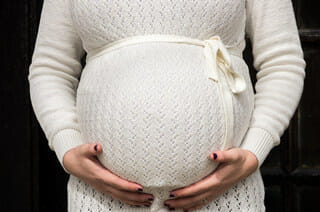
At week 34, the baby measures about 17.8 inches from crown to toe and can tell the difference between day and night. In fact, the baby sleeps with the eyes closed and opens them when awake. The mother’s belly feels lower than before because the baby is moving down in preparation for birth. The mother also experiences intense tiredness and sleep deprivation.
By week 35, the mother is extremely heavy since the due date is just around the corner. The constipation and sleep deprivation are starting to ease. The mother should seek medical attention if she feels extreme contractions or discomfort.
Once the pregnancy reaches week 36, the baby could arrive at any time. The baby’s entire body is active, and all the organs are fully developed. The mother has gained as much as 35 pounds now, and the baby weighs around 5.8 pounds. In the ninth month of pregnancy, mothers might feel a little discomfort on the pelvic bone because of the weight pressing down on it. If the baby’s head is not down by now, it may pose problems (such as a breech birth) during labor. If the mother is carrying twins, the babies are born around this time.
Around week 37, near the end of the pregnancy, most symptoms fade except fatigue and back pain. The baby is heavy now—6.3 pounds—and fully developed and would likely survive if it was born at this point.
At week 38, the mother needs to keep active to strengthen the pelvic muscles. Stay alert for any labor signs. If there are more frequent contractions accompanied by sharp pains, the baby is coming. Perhaps the best sign is the breaking of the amniotic fluid. If there is mucus on the underwear, this is also a sure sign that the baby is coming.
The baby is further down the belly by week 39 and is now days away. The baby is the size of a watermelon and weighs up to 7.25 pounds and measures up to 20 inches long. Mothers may have to undergo an ultrasound to determine the general health of the baby. By now the backaches and fatigue are almost gone, and mothers may feel a new rush of energy that will render them more active.
Week 40 is here. The baby is 20.16 inches long and weighs 7.63 pounds. The mother is pretty heavy and round by now and may have more anxiety. Focus on making the final preparations. Have the doctor on speed dial, and call if any symptoms out of the ordinary occur.
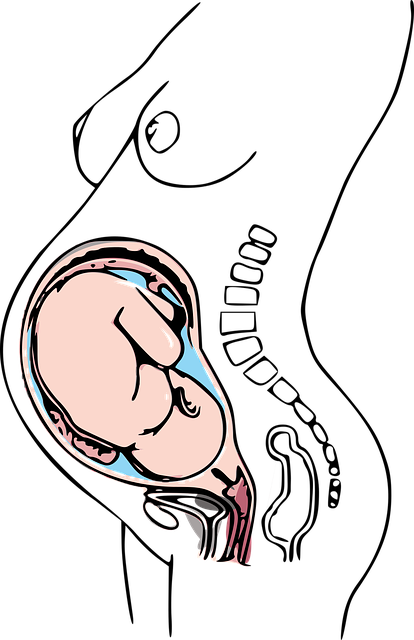
Third Trimester Note
As the third trimester progresses, stock up on anything the baby needs, such as baby clothes, diapers, warm blankets, and shawls. Don’t forget to also mentally prepare for the baby, and remember to pack a bag early in case you get caught off guard!
Maintain a healthy diet and lifestyle. Avoid alcohol completely to protect the baby from harm. Eat a low-carb diet and starch-free foods so that the baby does not become overweight. Stick to protein-rich foods and high-fiber foods to help boost the metabolism and reduce constipation. Eat more fresh fruits and vegetables. They will not only strengthen the mother’s immune system but the baby’s immune system as well. Drink plenty of water to keep the cells active and the body hydrated.
Some exercises mothers can do during the third trimester include light jogging, walking, light aerobics, skipping, lightweight or dumbbell lifting, and swimming. Concentrate more on exercises that strengthen the legs and the area around the waist, which will keep the muscles strong and prevent miscarriages and preterm accidents.
Conclusion
Pregnancy is a journey that varies for each woman. Some women may have their babies at as early as thirty-five weeks while others may have to wait as late as forty-two weeks. (Mothers might want to consider inducing labor if they do not feel any labor signs after the fortieth week.) What matters most is to enjoy the journey and to prepare oneself physically, mentally, and emotionally. If needed, consider attending classes to prepare for the baby. The labor experience is different from one woman to another. Do not compare yourself to others.

